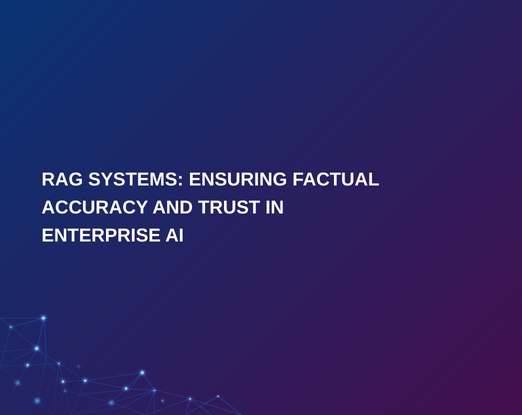Introduction to RAG Systems: What You Will Learn
Welcome to our exploration of RAG (Retrieval-Augmented Generation) systems, a pivotal development in the world of enterprise artificial intelligence. In this blog post, we will delve into the definition, components, and functionality of RAG systems. You’ll learn how these systems enhance the accuracy and reliability of AI-generated content while simultaneously fostering trust among users. We’ll also discuss why organizations should consider incorporating RAG systems into their AI strategy.
Understanding RAG Systems: Definition and Components
At its core, a RAG system uniquely combines a retrieval mechanism with natural language generation (NLG) to produce accurate and contextually relevant outputs. The retrieval component serves as a means to extract the most pertinent information from a vast pool of data, which is then utilized by the NLG to craft coherent and human-like responses.
This integrated approach allows RAG systems to overcome common challenges faced by traditional AI models. While conventional models may generate text based on patterns they have learned during training, RAG’s retrieval aspect ensures that the output is grounded in real, verifiable information. This synergy mitigates the risks of misinformation and enhances the overall performance of AI applications.
The Importance of Factual Accuracy in AI
In an era where information spreads rapidly, the factual accuracy of AI-generated content cannot be overstated. For enterprises, inaccuracies can lead to significant consequences, including misguided decision-making, a loss of customer trust, and potential damage to brand reputation. Moreover, with businesses increasingly relying on AI to analyze data and generate insights, embracing factual accuracy is pivotal.
For instance, consider a financial services firm using AI for market predictions. If the underlying data is flawed or misleading, the consequences could lead to substantial financial losses and deteriorated client relationships. Therefore, ensuring factual accuracy not only promotes better business outcomes but also reinforces customer and stakeholder trust in AI-driven processes.
How RAG Systems Enhance Accuracy
RAG systems improve accuracy through unique features like iterative feedback loops and advanced contextual understanding. When new information is introduced, RAG systems can adapt their responses based on this data, progressively refining their outputs for improved accuracy.
These systems employ data from verified sources, which makes them less susceptible to outright fabrications or errors common in traditional AI models. By ensuring that the content generated is backed by reliable data, RAG systems can significantly reduce the likelihood of producing misleading or inaccurate results, thereby enhancing the organization’s credibility.
Building Trust through Transparency
Trust is essential for the adoption of AI technologies, and RAG systems play a crucial role in cultivating this trust. One way they do this is through transparency about the sources of their information. Users can access the underlying data that informs AI-generated outputs, making it easier to evaluate their reliability.
Another aspect of trust-building is the incorporation of feedback mechanisms. By allowing users to provide input on AI-generated responses, organizations can improve the RAG systems dynamically. This not only fosters a sense of community but also ensures that the AI continually learns and enhances its responses, effectively creating a robust system that users can depend on.
Best Practices for Implementing RAG Systems
For enterprises looking to harness the power of RAG systems, the implementation process requires thoughtful consideration. Below are some best practices to ensure effective deployment:
- Training with High-Quality Datasets: Ensure that the data fueling your RAG system is accurate and up-to-date to foster high-quality output.
- Regular Updates for Relevance: AI technology evolves rapidly. Continual updates maintain the system’s relevance and accuracy over time.
- Comprehensive Evaluation Metrics: Configure evaluation metrics that prioritize factual accuracy to align with business outcomes.
- Utilize Suitable Tools: Implement platforms that facilitate RAG development, such as Hugging Face or OpenAI’s GPT models, to streamline the process.
These strategies will help organizations successfully integrate RAG systems, reaping the benefits of improved accuracy and user trust in their AI applications.
Conclusion: Ensuring Factual Integrity in Your AI Solutions
In conclusion, RAG systems represent a significant advancement in ensuring factual accuracy and building user trust in enterprise AI applications. The integration of retrieval mechanisms and natural language generation creates a powerful tool that businesses can wield to enhance decision-making, customer relationships, and overall operational efficiency. We invite you to share your thoughts on RAG systems and how they could transform your use of AI in the comments below. Your insights or questions are welcome!
Frequently Asked Questions
RAG systems, or Retrieval-Augmented Generation systems, combine a retrieval mechanism with natural language generation (NLG) to produce accurate and contextually relevant outputs from AI.
Unlike traditional AI models that rely solely on learned patterns, RAG systems incorporate a retrieval component that ensures outputs are grounded in real, verifiable information, enhancing accuracy and reliability.
Factual accuracy in AI is crucial as inaccuracies can lead to misguided decisions, a loss of customer trust, and potential damage to brand reputation, especially in enterprise contexts.
RAG systems improve accuracy through features like iterative feedback loops and advanced contextual understanding, allowing them to adapt and refine outputs based on new information.
Transparency allows users to access the underlying data used by RAG systems, making it easier to evaluate the reliability of AI-generated outputs and fostering trust in the technology.
Best practices include training with high-quality datasets, regularly updating the systems, using comprehensive evaluation metrics, and utilizing suitable tools like Hugging Face or OpenAI’s GPT models.
Yes, RAG systems significantly reduce the likelihood of producing misleading results by ensuring that the content generated is backed by verified and reliable data sources.
Iterative feedback loops allow RAG systems to learn from user input and new data, progressively improving their responses and maintaining relevance over time.
Tools such as Hugging Face and OpenAI’s GPT models are recommended for streamlining the development of RAG systems, facilitating integration and deployment.
By adopting RAG systems, businesses can improve decision-making, strengthen customer relationships, and enhance overall operational efficiency through accurate and trustworthy AI-generated insights.
